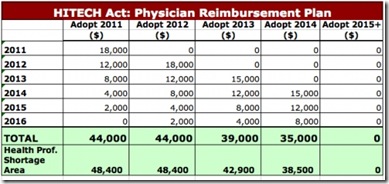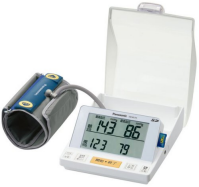An HIT Moment with ... is a quick interview with someone we find interesting. Vatsal Thakkar, MD is EMR Consultant and Assistant Professor of Psychiatry, NYU School of Medicine.
What’s good and bad about currently available EMRs for private practice physicians?
 The bad is an easy answer: the cost and complexity and commitment. The old model in EMR systems is that we pay huge fees upfront to acquire a static system which is basically housed on our premises. Then, we have to pay for maintenance and upgrades. It basically requires doctors’ offices to hire IT staff, so this model was typically only feasible for large practices or large organizations, like the outpatient offices associated with a hospital.
The bad is an easy answer: the cost and complexity and commitment. The old model in EMR systems is that we pay huge fees upfront to acquire a static system which is basically housed on our premises. Then, we have to pay for maintenance and upgrades. It basically requires doctors’ offices to hire IT staff, so this model was typically only feasible for large practices or large organizations, like the outpatient offices associated with a hospital.
Even with all of the expense, it was not necessarily cost-effective, because the costs of training, maintaining, and upgrading ate away at any benefits. Security was another matter — having an on-site site EMR was not much safer than having an on-site records room. It was still susceptible to disasters and malice.
The good news is that we are entering the Google-ification of all things Internet. What I mean by this is that services are now being offered across the board which are low-cost, low-commitment, low-complexity. They are scalable and this means that the barriers of entry are falling.
I myself started my solo practice with an EMR system which was very low cost ($50 per month), designed for my specialty (psychiatry), and was Web-based and involved no contracts. Therefore, the entry costs were very minimal. Within a year, I decided that system was not for me because it was slow and did not adapt well to my workflow and practice.
A company I had kept my eye on was Practice Fusion. They were offering what looked to be an easy-to-use system which was ad-supported and therefore free. However, the reason I switched was because I liked the EMR better and it actually made me more efficient in my workflow. The fact that it was free was icing on the cake.
Transitioning EMRs is no picnic, but I hired a grad student to help me download all of the old records to encrypted PDF files. The vendor was willing to get me a copy of my data, but I wanted to take this step to be ultra-safe. Ten years ago, or even five years ago, if I had opened a private practice, I would have had no affordable option to use an EMR — I’d be stuck writing in physical charts. This wouldn’t work for me because I have two offices and the lack of 24/7 access to records could have been a deal-breaker.
What functions are you using of Practice Fusion and how well does it work?
I am using many if not most of the functions of Practice Fusion. I use it to schedule patients, document office visits, phone calls, even e-mails from patients. I also use to internally as a secure way to message my assistant — it’s like tying an e-mail to a patient’s chart as a back-and-forth exchange among staff. When the communication is done, it gets saved as a chart document.
Finally, one of my favorite functions is that I use Practice Fusion to keep a detailed medication history and prescription log, and to print prescriptions. In New York, we have to write one medication per prescription on special security paper, which can be tough on the hand when doing it manually. With Practice Fusion, I can just point and click to print refills. If a dose needs to be changed, that is also a very easy modification. Then, each printed Rx is automatically a part of the chart which I can easily refer to in the future.
Practice Fusion also has an advanced insurance database for patients by region and there are add-on services for billing which integrate directly into the application to help streamline workflow. I am not using these because I don’t interface with insurance companies in my private practice.
Recently they have added document image uploading abilities so that old paper charts can be scanned and entered into Practice Fusion. I believe they are also working a deal with various nationwide labs to integrate lab ordering and results entry directly from/to the EMR interface.
With free EMRs like PracticeFusion and open source products available, is it really cost that’s holding doctors back from using them and should federal money be used to buy CCHIT-certified commercial products for doctors?
Cost is one of the issues. There is also an equipment issue because even with a free EMR, offices will need PCs, monitors, Internet access, and someone to take care of the machines (anti-virus and firewall, etc.)
Time and complexity is another issue. Transitioning to an EMR for a physician can be akin to changing a tire on an Indy racecar while it is still lapping. In some cases, it can be like changing all four tires while the car is lapping. It takes a lot of time, energy, planning, and devotion to successfully implement an EMR, especially for a group of doctors where there will be different styles and different opinions.
Finally, the last reason would be one that relates to human nature. We don’t like change. Things are always more comfortable the way they are. I would add that in terms of sheer speed and utility of documenting information, which is the core purpose of any medical record system analog or digital, there are few things that are as quick or reliable as writing with pen and paper. Pen and paper are easily available, don’t require electricity or an Internet connection, don’t require special training, don’t have outages, and so on and so on.
I think the EMR industry should bridge the gap better by trying to simulate pen and paper. This could be done with tablet PCs or digital clipboards like the Digimemo L2. Or perhaps there will be a future device — I personally would love to see the Amazon Kindle adopt tablet functionality. That would be the perfect marriage of great screen for text, low power consumption, and thin and light device. Data could be transferred wirelessly or by cable for security.
As a psychiatrist, how would you analyze the situation of doctors being blamed by outsiders for not embracing automation, for resisting the use of best practices and outcomes data, and for seldom participating in data sharing projects at a local and regional level?
Doctors usually have two goals: to provide good care to patients and to make money doing it. Some doctors value one of those tenets more than the other, but usually it’s in some sort of balance. There isn’t a level-headed doctor who would refuse automation if it was guaranteed to advance those two tenets.
The problem has been that there has been a promise of better care and lowering costs, but not the guarantee. In addition, doctors have been told, "You must invest $20,000-$50,000 now and you will reap the rewards in 2-5 years." As a doctor, I have absolutely no obligation whatsoever to do anything purely in society’s best interest! I hope to do things in my best interests which I hope will also help society.
It’s important to think about workflow — think 20 years ago — whether a physician was rounding at the hospital or seeing office patients, he or she was writing all the time — by the bedside, at the nurse’s station, etc. This writing, in the form of progress notes and orders, was then finalized in a spare moment between patients and the physician moved on.
I so often see that administrators and non-clinical personnel don’t see that the introduction of a computer workstation and monitor is a change in workflow, but it can be a huge one. Now all of the note and order writing has to occur as discrete segments of time. Even if the doctor took notes in the patient’s room, those handwritten notes have to be re-entered into the computer. If the physician is doing this 20 times a day or more, even if it adds five minutes per patient, that adds up to over 1 ½ hours per day, which seriously affects quality of life or income generation (but usually both).
When I was involved with implementing a campus-wide EMR system at Vanderbilt University Medical Center, no one had thought of the simple act of typing. Most of us under 40 (especially those under 30) have usually learned how to type as a natural means of communication. But what about those who were still hunting and pecking at the keyboard? There was no provision for getting someone typing lessons, which is the result of a less-than-perfect strategy. The end product is that the notes suffer because if I was posed with the decision of cutting corners on my note-writing vs. being an hour and a half late to go home every day, guess what — I have a wife and a toddler at home … I’m skimping on my notes.
In general, I hate to say that I have often seen the quality of medical documentation go down with the advent of the EMR. One scourge is the concept of insert pre-written text. It is meant as a means of speeding things up, but unfortunately what happens is that sometimes progress notes become fantasy documents that have little connection to reality. Or they all look and sound the same. The practice of medicine is a thoughtful, nuanced craft (even within the concept of practice protocols and guidelines) and that information has to be accurately conveyed in the medical record.
Best practices and outcomes data: in general, physicians should pay attention to these things. One of the problems is that these guidelines often develop prematurely and then have to changed or even reversed. So I think that most physicians should follow guidelines which have the best evidence-base backing them and in general this will improve quality of care and outcomes.
Participating in data-sharing projects also falls under the "better for society than for me or my practice." Therefore, without incentives, this is not going to automatically happen.
As a psychiatrist, using an EMR works for me because I have an office-based practice and I am a good typist. Another essential feature for me has been a wireless, whisper-quiet keyboard (Microsoft makes some good ones). This has allowed me to unobtrusively type a rough note while making eye contact with my patient. Sometimes I’ll have the wireless keyboard in my lap as I leisurely sit and face my patient and it seems to work for my practice.
What are your thoughts on patient privacy when it comes to electronic systems, data sharing, and vendors who manage and possibly sell patient information?
Of course I have had my concerns. With the introduction of federal guidelines (HIPAA) I am assured in the very least that if there is a confidentiality violation, someone can be held accountable, whether it’s a doctor, an EMR vendor, or a third party.
I believe there are guidelines on how the data servers on an EMR can be set up and run. Everything has to be encrypted while traveling the Internet. In the end, if banks and even the IRS can use web access functionality, I think we are okay to do the same.
The phrase "selling patient information" sounds very harsh but is a bit misleading. It is not legal to sell any identifiable patient data without consent of the patient. However, HIPAA stipulates that certain de-identified data can be disclosed or sold. The plus side of this may be better quality returns through the analysis of aggregate data. For example, it could be learned that a certain drug is causing complication X in certain patients. This data could be ascertained in real time.
I don’t see a downside for patients other than a psychological one: the fact of knowing that their private information may be contributing to the healthcare data marketplace out in the world somewhere. For physicians, I think it could be worse. I’m sure this can and will be used by government agencies and perhaps drug companies to see who is recommending more tests (and therefore using more healthcare resources), who is prescribing which medications (potentially a huge draw for pharmaceutical marketing), and who is abiding by appropriate treatment guidelines. As you can see, not all of these are bad (i.e., the last one). For now, I am content with the ease and efficiency that it affords me and I think that we as an industry and as a society will adequately deal with the issues as they come up. But it will probably be a bumpy ride.








Re: Walmart Health: Just had a great dental visit this morning, which was preceded by helpful reminders from Epic, and…